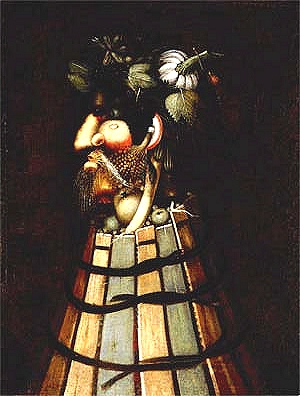| Follower of Giuseppe Arcimboldo Italian, c 1527-1593
AN ALLEGORICAL HEAD REPRESENTING AUTUMN (SN 672)
AN ALLEGORICAL HEAD REPRESENTING SUMMER (SN 673)
SN 672, 673, oils on canvas
From "The Pages".
|
|
|
 
ORIGINAL ARTIST:
Giuseppe Arcimboldo was an Italian painter, draftsman, and tapestry designer. He was also
active in Austria and Bohemia. He came from a distinguished, religious Milanese family
that included a number of archbishops of the city. He worked with his father, also a
painter, in the Milan cathedral, as well as collaborating with others in various
cathedrals.
He was an established painter when he was called to the Viennese court of Emperor
Ferdinand I, in 1562; apart from a couple of visits to Italy, he remained at court in
Vienna and Prague. His noble status was confirmed by Rudolf II in 1580. Among his perks
was a trip to Germany in 1582 to buy antiquities and rare objects for the imperial
collections.
Nothing in his previous works, however, prepared the way for his most famous invention:
the series of composite heads made up from objects pertaining to the seasons. They were
commissioned as curiosities for a private “cabinet,” and illustrated naturalism
in art. These were certainly the most celebrated of his paintings in Arcimboldo’s own
time, and along with his festival designs, made his name.
Those composite heads established a type that was often used subsequently, and he was
rediscovered in the 20th c by the Surrealists and other fantastic painters or followers of
Dada.
SUBJECTS:
Fruits, grains, and vegetables combine to create two “portraits.”
Arcimboldo’s original series was much copied and imitated in his lifetime. Such works
may best be regarded as “serious jokes.” The notion is an expression of the
Renaissance love for paradox, wherein serious content would be expressed in fanciful form.
From antiquity it was thought to be a sign of a ruler’s urbanity that he could both
tell and take a joke.
PAINTINGS:
The Museum refers to these two as Arcimboldo’s because they were done by a copyist
from the artist’s slightly different originals. Literary allusions are being
translated into literal representations from nature: cheeks like peaches or red as apples,
teeth as regular as peas in a pod, etc. Arcimboldo was taking aim at the Italian principle
of painting only to commemorate important people and events, by presenting a more common
parlance.
At the same time, it elevates the everyday into “allegory,” therefore more
worthy of respect. This type of painting precedes outright still-life by about 40 years
– but the still-life wouldn’t have happened without this precedent.
HISTORICAL CONTEXT:
Further interpretation of the heads is possible, thanks to the surviving poems by Giovanni
Battista Fontana, who was possibly an artistic collaborator at court from 1568 to 1571.
The poems were presented at court along with Arcimboldo’s seasonal series, and show
that those paintings were intended as allegories on imperial rule. Individual pictures,
adorned with numerous Hapsburg symbols, were related to each other, suggesting that as the
Hapsburgs ruled the world of states, so they may be seen to hold sway over the universe.
ringlingdocents.org
|